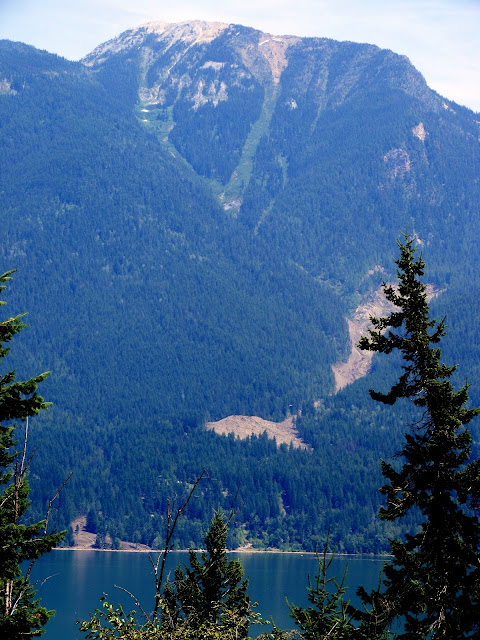When I first
heard the words Johnson’s Landing crackling across the air waves last week, I
thought what on earth can this be about. Johnson’s Landing on the beautiful east
shore of Kootenay Lake 20 miles north of Kaslo is about as obscure of a place as
you can find anywhere in the Kootenays and fewer than 30 brave souls live there.
How on earth did
this idyllic hamlet get into the news I wondered with great
alarm.
Well, we all
know now and our hearts can only go out for the landslide tragedy that took
place there. Four lives have been
cruelly snuffed out and it easily could have been more considering the size of
the slide which thundered down from the high peaks of the Purcell Range about 80
miles directly northwest of Cranbrook, but much farther if you drive.
So drive is
exactly what I did and it took almost four hours to navigate the windy road to
Kaslo including the Kootenay Lake ferry and the gravel stretch down to the scene
of the slide. But the best look I got of it was with my binoculars from the
opposite side of the lake directly across from Johnson’s
Landing.
It was a pretty
impressive look.
The slide must
have started from near the 8,000 ft. level of Kootenay Joe Mountain, which is
just outside the Purcell Wilderness Conservancy and still covered with the odd
snow patch. It looked like it originated in several steep ravines at that level
with the various smaller volumes of dirt, debris and mud combining lower down to
form one giant stream of rock, rubble, splintered trees and mud which roared all
the way down to the lake shore sweeping away everything in its
path.
Given the
steepness of the slopes, the slide must have moved really fast giving the
victims below no real chance or warning to get out of its destructive path. One
Johnson’s Landing resident, who was incredibly lucky to live just beyond the
edge of the destruction, got a warning only hours before when she noticed the
normally crystal waters of Gar Creek silting up and a lot of wooden debris
floating down the swollen creek. She fired off an email to the Ministry of
Forests but no one saw it until after side of the mountain broke
away.
Now, of course,
comes the “why game” and the “blame game,” but frankly I don’t think there is
much to say about the latter. As I drove over to Kootenay Lake, one of the
things I was wondering about was clear-cut logging, which has been rightfully
blamed for many Kootenay slides over the years. But after carefully scoping all
the slopes around and above the torrent of rock I could see no evidence of
logging whatsoever. In fact, most of Gar Creek’s drainage appeared to be covered
by mature timber so logging of any kind can definitely be ruled
out.
What then? A
geological fault? Quite possibly. A small earthquake. Also possible, but no
evidence of that yet but it shouldn’t be ruled out because the 1960’s slide that
many of you will have driven through on the Hope-Princeton Highway was
eventually blamed on a small earthquake in Washington state just to the
south.
And then there’s
the standard bugbear of global warming. Many will roll their eyes at this point,
but you shouldn’t be too quick.
An article in
the Vancouver Sun this week said the slide should be a “wake up call” that
climate change is increasing the risk of slide incidents such as the Johnson’s
Landing slide and the one at Fairmont and a series of small slides following a
big rain storm in Castlegar Tuesday.
Unstable slopes
are a fact of life in all mountainous areas and when you combine that with
increasingly erratic weather associated with climate change you’ve got the
potential for tragedy. The heavy snowpack this year, combined with a late spring
and one of the wettest Junes on record with Cranbrook airport recording 123 mm
of rain (about five inches) the local mountains have got awfully soggy and that
has got to be a concern.
Could a slide
tragedy happen around Cranbrook? No one can say for sure. But City Public Works
Director Joe McGowan says there are electronic silt and turbidity detectors at
the intake just above the Phillips Reservoir that should give an early warning
if a slide event happened in the upper reaches of Joseph
Creek.
This is cause
for comfort, but one can never be too sure.
Gerry Warner is
a retired Cranbrook journalist and a Cranbrook City councillor. His views are
his own and he is not speaking for Cranbrook Council.


No comments:
Post a Comment